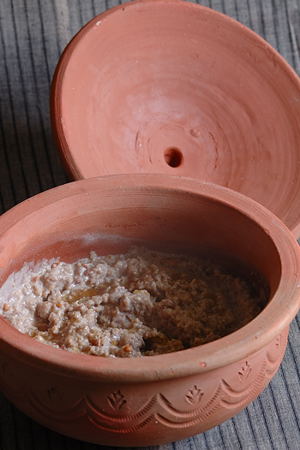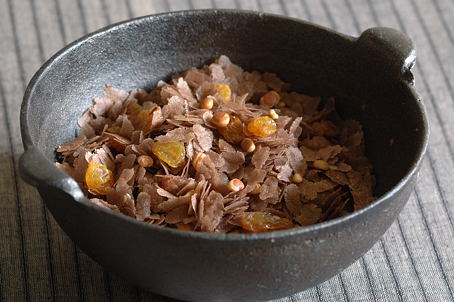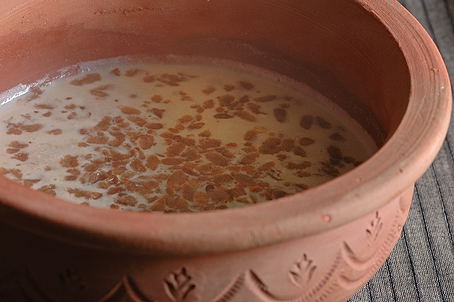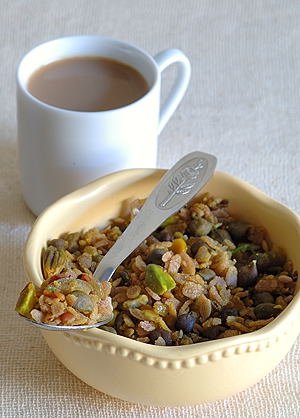à°…à°Ÿà±à°•à±à°² పాయసమà±

Claypot Cooking: Poha Payasam with Almond Milk
I had been looking for a decent clay pot for cooking for a long time. Last weekend, I have come across one at a local grocery shop called Apna Bazar. The clay pot is from India, very well crafted and decorated with pretty floral design. The size is good and it also has a well-fitted lid. Price $12.
I brought the clay pot home, prepped it by soaking in water and then simmering the water for few times, half an hour each time. Simmering was done on stovetop following the clay-pot cooking principles. First warm the pot on low heat and then gradually increase the heat to medium level. I never tried high heat setting fearing that it might crack. Although it was on electric stovetop, this method has worked very well. Like the iron box on steam setting, the clay pot hissed every time, but absorbed this newbie trails kindly. I felt confident enough to try out the real deal and did the opening ceremony with payasam preparation yesterday. The sweetness that comes with clay pot cooking, combined with sweetness of the payasam, it was a good experience.
The following poha payasam with almond milk is very easy to make. And I think, it has a taste that delights most everyone. If you prefer, semiya or sabudana can be substituted for poha.

Toasted Poha, Golden Raisins and Chironji Nuts
Recipe:
(for two to four people, for one meal)
3 cups almond milk (badam paalu)
½ cup maple syrup (or sugar to taste)1-tablespoon ghee
2- tablespoons golden raisins
1-tablespoon chironji (Saarapappu or charoli)
1-cup poha (atukulu, rice flakes)
1 teaspoon freshly crushed cardamom
1. Place almond milk in a wide pot on stovetop. Add maple syrup. Slowly, on medium-low heat, simmer for about 20 minutes, until three cups have reduced to about two and half cups.
2. While almond milk is simmering, in a small kadai or wok, take ghee. On medium heat, warm the ghee. Add golden raisins and saute, constantly stirring. Wait until they puff up like round balloons. It’s a beautiful sight and worth the wait. With a slotted spoon, remove the balloons to a plate.
Add chironji nuts to the kadai. Toast them to pale red. Take them out and add poha. Toast for couple of minutes just until they are warm to touch. Together, they will look like shown in the photo above.
3. Add the toasted poha, golden balloons and chironji nuts to simmering almond milk. Sprinkle the crushed cardamom. Mix. Turn off the heat immediately. Cover the pot and let the poha absorb the almond milk. Poha is like cereal flakes, softens quickly.
Serve hot or at room temperature. Just before serving, drizzle a tablespoon of maple syrup. This poha paysam with almond milk is as nutritious as it is tasty and makes a comforting dessert for people who fear the hormonal effects of regular milk and soymilk.

Claypot Cooking: Poha (Atukula) Payasam with Almond Milk
*****
Slow connection, server problems. Sorry for the inconvenience.
*****


